10 Natural Insecticides for plants: Homemade insecticide How to get rid of pests?
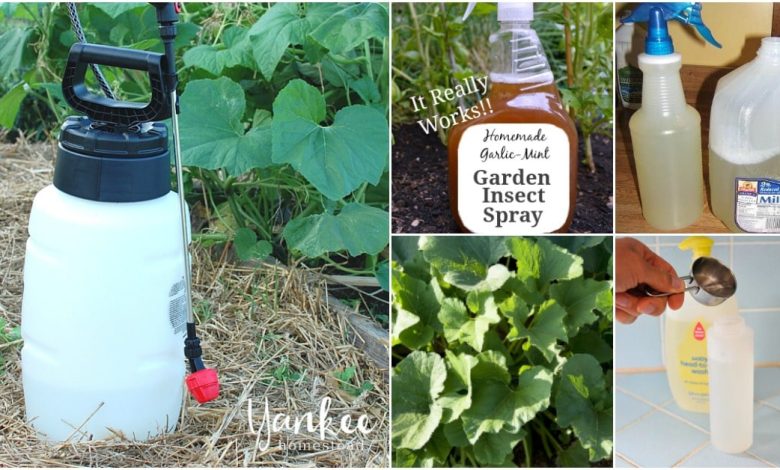
We have already talked about natural insecticides in other Agrohuerto posts, but today we will do a general review in which we will see 10 of the most used natural preparations in organic gardens to control pests.

Insects such as aphids or whiteflies, mites such as red spiders or mammals such as rodents can become crop pests and ruin our harvest. Therefore, we must prevent their appearance or control them with insecticides and pesticides like the ones we will see today.
These ecological remedies are respectful with the environment and with health. Natural insecticides are used to combat pests naturally in orchards and organic gardens, where artificial chemicals cannot be used.
What are natural insecticides?
Natural insecticides are preparations used in organic farming to combat crop pests.
These natural insecticides can be based on plant extracts, microorganisms that kill pests (such as some bacteria and fungi used in biological control), or based on natural products of mineral origin, such as sulfur.
There is a wide variety of natural insecticides for the organic garden. Most can be purchased at garden stores and other specialty stores, but some can also be prepared at home.
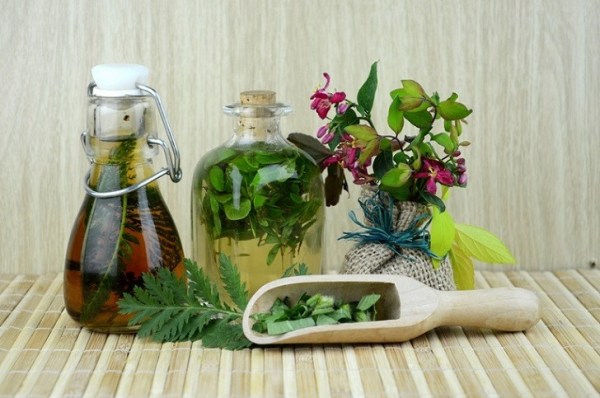
In any case, all natural insecticides have one thing in common, and that is that they are not synthetic chemicals. On the contrary, these insecticides are made up of natural ingredients (either organic -such as plants-, or inorganic -such as powdered sulfur and mineral oils that we will see in today’s post-).
Benefits of natural pesticides
The benefit of using these products lies not only in the environmental aspect (being natural products they will not pollute the air, soil or nearby waters -aquifers or water from wells, lakes, ponds…), but there are also direct benefits for the people.
Growing an organic garden has multiple health benefits … The main one is that the products we harvest are much more natural and do not have traces of chemicals or poisons for pests. If, instead of using those traditional chemicals, we use these natural insecticides, we will be protecting not only biodiversity and the environment, but also our own health.
Below we will see several preparations that can be used as natural pesticides for plants. (Some of these organic insecticides can be prepared at home, and others are readily available online or at specialty stores.)
1. Neem tree oil and other vegetable oils
Azadirachtin is the active ingredient in «Neem Oil». This compound is extracted from the seed inside the fruit of the Neem Tree (scientific name: Azadiratcha indica).
Neem oil is widely used in organic gardens because it is a natural broad-spectrum insecticide that is effective against various pests: aphids, mites (such as red spiders or white spiders), whiteflies, nematodes, lepidoptera, cottony mealybugs, thrips …
Another type of vegetable oil useful as a natural insecticide is peppermint oil. Recently one of our readers told us in one of the blog comment threads that peppermint oil is an effective repellent for mice, mice and other rodents that can become pests in the garden.
2. Paraffin oil and other mineral oils
Paraffin is a natural insecticide against pests as common as aphids, red spiders, whiteflies, mealybugs or thrips. Paraffin oil leaves a waxy coating on the insects preventing them from breathing until they die. You have to dilute a small spoonful of liquid paraffin in 5 liters of water and spray the solution on the insects.
Insecticidal mineral oils known as «summer oil» or «winter oil » are also natural broad-spectrum insecticides. That is, they serve to fight against various types of pests. They are usually made with paraffin oil or other hydrocarbons.
3. Homemade garlic and onion spray
Garlic and onion are powerful bactericides and fungicides, so preparations made with these plants will help prevent and cure diseases caused by fungi and bacteria. But this preparation is not only effective in curing common diseases of garden plants, it can also be used to make natural insecticides against pests such as aphids and mites.
Idea to prepare a homemade «garlic and onion spray»: mix five or six crushed cloves of garlic with half a large onion or a medium onion in pieces and add a liter of water. Let stand for 24 hours. Then boil for 20 minutes over low heat and strain the decoction.
Chillies or hot peppers can also be added to this homemade natural insecticide. In the Sanyuanli Community Garden, in Beijing, they made macerations with garlic and chilli to prepare natural insecticides.

4. Pyrethrum
Pyrethrum is a powdered natural pesticide that is prepared with extracts from the flowers of Chrisantemun cinerarifolium or Anacyclus pyrethrum.
Pyrethrum is used to fight common pests such as aphids, whiteflies or red spiders. One drawback of pyrethrum is that it is also toxic to beneficial insects such as bees, so it should be used sparingly and very occasionally. You also have to
Its method of use must also be respected, bearing in mind that it must be applied in a low concentration -maximum 25%- so it must be mixed with another powder before applying (talcum powder for example) or dissolved in liquid organic solvents that facilitate your application.
5. Rotenone
Rotenone is another of the natural insecticides that come from plants. It is obtained from the roots of the Derris elliptica plant.
It is effective against pests such as beetles, thrips, caterpillars, mites or aphids. It is applied in the same way as pyrethrum: by sprinkling it or diluted.
6. Horsetail slurry
Horsetail is one of the most used plants to make natural remedies against pests and diseases in organic gardens. It is very effective against garden fungi, but it is also useful for repelling snails and slugs and for fighting pests such as aphids and red spiders.
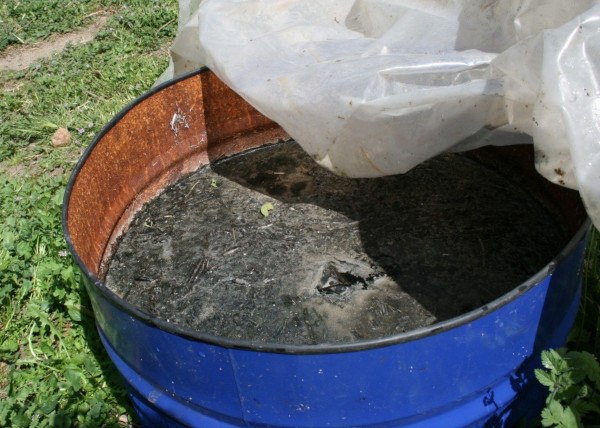
Horsetail slurry can be made by macerating several of these plants in a container of water (as in the image above) or you can also make an infusion or decoction at home. Boil 50 grams of dried horsetail (or 100 grams if fresh) in 5 liters of water for one hour. After letting it stand until it cools, pass through a sieve and spray the decoction diluted 20% with water on the plants.
7. Quassia
Like pyrethrum, it is a natural powder pesticide that is also obtained from a plant. In this case, the quassia comes from the wood or bark of the Quassia amara tree.
This natural product prevents several common pests such as the potato beetle or the aphid.
8. Soapy water
The traditional «grandmother’s soap» or homemade soap. It can be bought but it must be completely natural and made with potash (not soda, which is very corrosive to plants). Use a grater to make small particles and boil it in a little water to dissolve it well. Then add a liter of water for every 30-40 g of soap and spray with it the insects, eggs or spider webs that you see. (It is better to apply at dusk since it is not advisable that it is exposed to the sun when it is just applied).
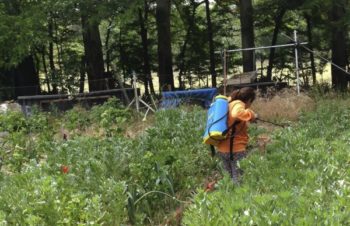
It is effective against aphids, whitefly, thrips, mealybugs, red spider and also against some fungi such as bold or botrytis…
9. Sulfur
Powdered sulfur or micronized sulfur is used in organic gardens as a natural fungicide against powdery mildew and other common fungi. But it is also effective against pests, so it is used to fight repel insects in general.
It can be applied by sprinkling it directly, although it adheres better if it is mixed with a specific liquid solvent for this use. You can mix powdered sulfur with a sticky-dispersive liquid, with those two liquids separately, or use «wettable sulfur» and mix it with water. It should be applied at a temperature between 10 and 25 ºC (on hot days better at sunset).
10. Bacillus thuringiensis and other natural insecticides prepared from bacteria and fungi
Biological control is the use of living organisms or beings to control pests and diseases. It is an environmentally friendly method widely used in organic farming.
This biological control includes the use of repellent plants, insects that eat pests, but also preparations made from microorganisms (such as bacteria and fungi) that turn out to be pathogenic for pests and end up eliminating them.
An example are those prepared with the bacterium Bacillus thuringiensis, which are used to eliminate Lepidoptera pests -moths and butterflies and their larvae, the caterpillars- (such as the Tuta absolute, the cabbage butterfly…). It is a powder that contains thousands of colonies of this bacterium and that is applied diluted in water and sprayed on the plants.
There are other natural insecticides for pest control with microorganisms. For example, the fungus Beauveria bassiana is used to prepare effective pesticides against insects such as whiteflies, aphids, bedbugs, or weevils. And the Saccharopolyspora spinosa bacterium is used to prepare the well-known Spinosad, against pests such as the olive fly, thrips or Lepidoptera.
I hope that this list of natural insecticides for the organic garden has seemed useful to you. If you know of other organic pesticides for pests and diseases or if you have any questions, do not hesitate to use the comment thread below.
In addition to using natural insecticides, it is important to follow other integrated control techniques to eliminate unwanted insects. Crop rotation and beneficial associations, the use of local varieties or the use of biostimulants are some of them… Find out more in the article on Integrated Pest Control: What it is and main techniques.
References
- SENA, 2000. How are plant extracts made and how are they applied in fungicide and insecticide fertilizers? National Apprenticeship Service of Colombia. Training Videos, Series: Organic Farming.
- O’Farrill-Nieves, H. & Medina Gaud, S., 2007. Common garden pests, identification and integrated management. University of Puerto Rico, Agricultural Extension Service.
- Pérez, N. & Vázquez, L., 2004. Ecological Pest Management. Transforming the Cuban Countryside: Advances in Sustainable Agriculture, p. 191-223. CEDAR Agrarian University of Havana (Cuba).

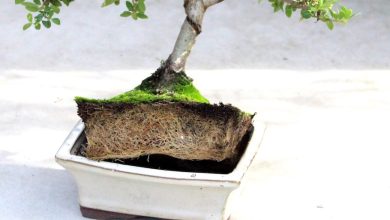
![Photo of Prune Kiwis: [Importance, Season, Tools, Considerations and Steps]](https://www.complete-gardening.com/wp-content/uploads/2022/08/prune-kiwis-importance-season-tools-considerations-and-steps-390x220.jpg)

![Photo of How to Plant Padrón Peppers: [Complete Guide]](https://www.complete-gardening.com/wp-content/uploads/2021/06/Pementos_de_Padron-390x220.jpg)